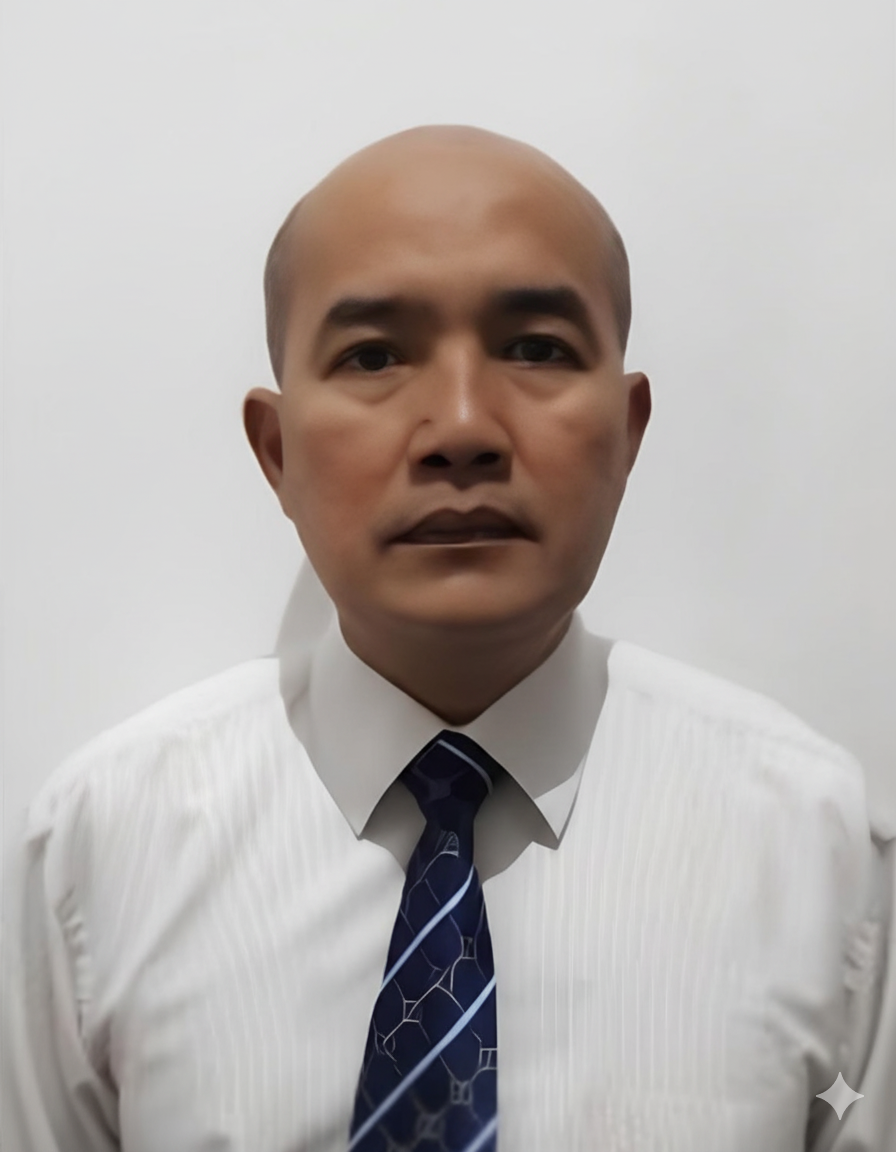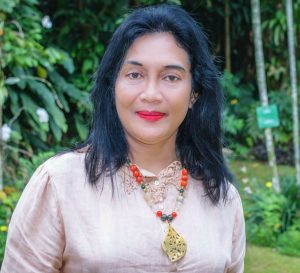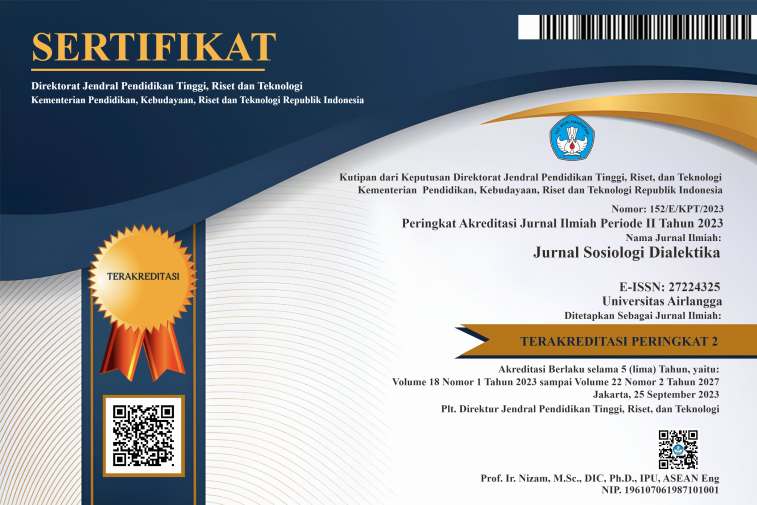Aesthetics, simulacra, and lifestyle consumption: A social practice in the representational space of “Ada Apa Dengan Kopi” café on Gen-Z
Downloads
This study examines the symbolic and aesthetic construction of the coffee shop Ada Apa Dengan Kopi as a simulacrum—a representation that mediates and dominates social reality—and its implications for consumption practices and identity formation among Generation Z. Employing a qualitative phenomenological approach, the research seeks to understand the subjective meanings that Gen Z visitors construct through activities such as socializing, studying, working from the café (WFC), and taking personal “metime” within the café space. Drawing on Jean Baudrillard’s theories of simulacra, simulation, and hyperreality, the analysis highlights how aesthetic elements (interior design, product presentation, atmosphere) function as signs that not only reflect reality but also shape and precede the café’s social reality. The findings reveal that Ada Apa Dengan Kopi provides a representational space in which Gen Z individuals perform their social and aesthetic identities, experience existential fulfillment and prestige amid the fragility of everyday reality. This space constructs a hyperreal condition where coffee becomes not only a commodity but also a symbol of status and identity and a stage for lifestyle performance. Thus, this coffee shop becomes a simulacrum, namely, the social reality of Gen Z is constructed through signs and aesthetics that paradoxically produce consumption and social interaction in the context of contemporary urban culture.
Abdusshomad A (2021) Gaya hidup nongkrong di kafe dan perilaku gosip sebagai kontrol sosial. Al-Adabiya: Jurnal Kebudayaan dan Keagamaan 16 (1):57-68. https://doi.org/10.37680/adabiya.v16i1.593.
Aisafitri L & Yusriah K (2020) Sindrom fear of missing out sebagai gaya hidup generasi milenial di Kota Depok. Jurnal Riset Mahasiswa Dakwah dan Komunikasi 2 (4):2656-8330. http://dx.doi.org/10.24014/jrmdk.v2i4.11177.
Arisanti P (2021) Tren gaya hidup milenial, identitas sosial dan desain coffee shop. Jurnal Manajemen Bisnis 18 (4). https://doi.org/10.38043/jmb.v18i4.3318.
Bado B, Tahir T, & Supatminingsih T (2023) Studi social climber Gen-Z dan perilaku ekonominya. Journal of Economic Education and Entrepreneurship Studies 4 (1). https://doi.org/10.26858/je3s.v4i1.396.
Bakti IS, Nirzalin N, & Alwi A (2019) Konsumerisme dalam perspektif Jean Baudrillard. Jurnal Sosiologi USK (Media Pemikiran & Aplikasi) 5 (2):147-166.
Baudrillard J (1998) The Consumer Society: Myths and Structure. In: Turner C (trans). London: Sage Publications.
Baudrillard JP (1994) Simulacra and Simulation. In: Glaser SF (trans). Michigan: University of Michigan Press.
Baudrillard JP (2018) Masyarakat Konsumsi. In: Wahyuno (trans). Yogyakarta: Kreasi Wacana.
Chammearc NS, Firdaus FF, & Sianturi WR (2023) The self-concept of teenagers who hangout in cafe: A survey on student. Indonesian Journal of Multidiciplinary Science 2 (7):2832-2839. https://doi.org/10.55324/ijoms.v2i7.481.
Chang JY, Sik KD, & Hayub S (2015) A study on the simulated surface effect in contemporary architecture: the relationship between simulacra and digital fabrication technology. Journal of Asian Architecture and Building Engineering 14 (1):25-32. https://doi.org/10.3130/jaabe.14.25.
Creswell JW (2014) Research Design: Pendekatan Metode Kualitatif, Kuantitatif, dan Campuran Yogyakarta: Pustaka Pelajar.
Firamadhina FI & Krisnani H (2022) Perilaku generasi Z terhadap penggunaan media sosial TikTok: TikTok sebagai media edukasi dan aktivisme. Social Work Jurnal 10 (2):199-208. https://doi.org/10.24198/share.v10i2.31443.
Fitriani K, Kurniawan A, & Walimah S (2021) Strategi pemasaran kedai kopi “Coffee Et Bien” Kota Metro Lampung. Derivatif: Jurnal Manajemen 15 (1):21-28. https://doi.org/10.24127/jm.v15i1.573.
Husserl E G (1999) The Crisis of European Sciences and Transcendental Phenomenology: An Introduction to Phenomenological Philosophy. In: Carr D (trans). Illinois: Northwestern University Press.
Igiasi TS (2017) Kedai kopi sebagai ruang publik: Studi tentang gaya hidup masyarakat Kota Tanjungpinang. Jurnal Masyarakat Maritim 1 (1) https://doi.org/10.31629/jmm.v1i1.1660.
Kessel CV, Manriquez JD, & Klip K (2025) Baudrillard, hyperreality, and the ‘problematic’ of (mis/dis) information in social media. Theory & Research in Social Education 53 (2):249-271. https://doi.org/10.1080/00933104.2024.2439302.
Lubis AS & Elida L (2024) Simulation of society in developing countries Indonesia: Interpretation study of student consumers of Starbucks coffee in Medan City. Wedya: Journal of Multidisciplinary 1 (1):10-20. https://jurnal.literasipublisher.co.id/wjm/article/view/22.
Marbawani G & Hendrastomo G (2020) Pemaknaan nongkrong bagi mahasiswa Yogyakarta Dimensia: Jurnal Kajian Sosiologi 9 (1).
Mubaroq H & Aisyah R (2021) Pengaruh intensitas kebiasaan nongkrong terhadap pembentukan perilaku social climber: Studi pada mahasiswa Universitas Panca Marga Probolinggo. Jurnal Ilmu Sosial dan Ilmu Politik Malikussaleh (JSPM) 2 (2):264-275. https://doi.org/10.29103/jspm.v2i2.5668.
Polishcuk OP (2019) Simulacrum, aesthetic experience and modern artistic practice in the context of principle "incomplete understanding of the object". Zhytomyr Ivan Franko State University Journal. Philosophical Sciences 1 (85):76-84. https://doi.org/10.35433/PhilosophicalSciences.1(85).2019.76-84.
Pramelani (2020) Faktor ketertarikan minuman kopi kekinian terhadap minat beli konsumen kalangan muda. Management Insight: Jurnal Ilmiah Manajemen 15 (1):121-129 https://doi.org/10.33369/insight.15.1.121-129.
Priyanti WG, Sulismadi, & Kumalasari LD (2022) Gaya hidup nongkrong mahasiswa di Malang (Studi pengunjung kedai kopi or traffic Sengkaling Kabupaten Malang). Jurnal Sosiologi Nusantara 8 (2):265-278. https://doi.org/10.33369/jsn.8.2.265-278.
Putri AA & Hidayah S (2024) Self healing generasi Z: Bentuk baru perilaku konsumtif pada mahasiswi. FISIP ULM Huma: Jurnal Sosiologi 3 (3):245-254. https://doi.org/10.20527/h-js.v3i3.230.
Rahayu LM, Noorman S, & Fakhrunnisa R (2019) Kopi Priangan: Pengukuhan identitas melalui budaya ngopi dan bermedsos (media sosial). Jurnal Sosioteknologi 18 (3). https://doi.org/10.5614/sostek.itbj.2019.18.3.8.
Raho B (2021) Teori Sosiologi Modern (Edisi Revisi). Yogyakarta: Ledalero.
Saputri DA, Lestari NB, & Firinanda R (2023) Representasi image anak muda dalam budaya ngopi. Tuturan: Jurnal Ilmu Komunikasi, Sosial dan Humaniora 1 (2):122-135. https://doi.org/10.47861/tuturan.v1i2.162.
Shaheen MM, Saeed SA, & Naeem A (2022) Dystopic simulacra, virtual identities and cultural implosion in Shteyngart's Super Sad True Love Story. Global Sociological Review VII (I):116-124. https://doi.org/10.31703/gsr.2022(VII-I).12.
Suryani CD & Kristiyani DN (2021) Studi fenomenologi pada gaya hidup baru anak muda sebagai pengunjung coffee shop di Salatiga. PRecious: Public Relations Journal 1 (2). https://doi.org/10.24246/precious.v1i2.4769.
Syahryari M (2025) A phenomenological study of the hidden life of cafes and the construction of women's identity. Quarterly Journal of Women Social and Psychological Studies 23: 41-47. https://doi.org/10.22051/jwsps.2025.46840.2866.
Viviani D (2013) Food, mass media and lifestyles: A hyperreal correlation. Italian Sociological Review 3: 165-175. https://doi.org/10.13136/isr.v3i3.67
Widiawati, Idrus II, & Mario (2023) Perilaku nongkrong anak muda di café: Studi pada pelanggan coffee shop Kedai Rakyat di Watampone. Jurnal Predestination: Journal of Society and Culture 5 (1):84-93. https://ojs.unm.ac.id/predestination/article/view/53168/23639.
Yanto A & Hikmah F (2023) Fenomena centang biru Instagram: Analisis masyarakat konsumsi dalam perspektif simulakra Jean Baudrillard. Jurnal Humaya: Jurnal Hukum, Masyarakat, dan Budaya 3 (2):163-174. https://doi.org/10.33830/humaya.v3i2.6236.
Yuana L (2023) AADK Coffee & Eatery Wiyung tawarkan lima ruang tematik. Times Indonesia, 8 July. [Accessed 25 March 2025]. https://timesindonesia.co.id/kuliner/460612/aadk-coffee--eatery-wiyung-tawarkan-lima-ruang-tematik.

This work is licensed under a Creative Commons Attribution-NonCommercial-ShareAlike 4.0 International License.
1. Copyright of this journal is possession of Editorial Board and Journal Manager, by the knowledge of author, whilst the moral right of the publication belongs to the author.
2. Legal formal aspect of journal publication accessibility refers to Creative Commons Attribution-NonCommercial-ShareAlike (CC BY-NC-SA), implies that publication can be used for non-commercial purposes in its original form (cannot be modified).
3. Every publications (printed/electronic) are open access for educational purposes, research, and library. Other that the aims mentioned above, editorial board is not responsible for copyright violation.















